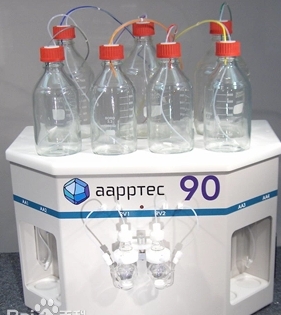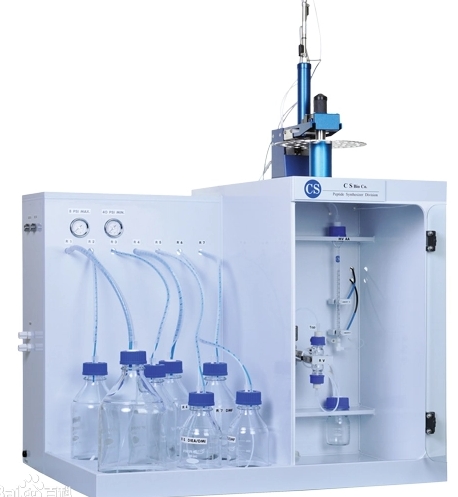Automated Peptide Synthesizer

This article is a complete guide to peptide synthesizers, covering the classification of automated peptide synthesizer, their operating principles, their advantages and disadvantages, and the most widely used types today. We believe this will be of great help when purchasing a peptide synthesizer. Omizzur specializes in custom peptide synthesis. This article has about 1500 words and takes 4 minutes to read.
The Birth of Solid Phase Peptide Synthesis
Research on peptide synthesis has gone through a glorious history of more than one hundred years. In 1902, Emil Fischer first began to pay attention to peptide synthesis. Because there was too little knowledge in peptide synthesis at that time, progress was very slow. It was not until 1932, when Max Bergmann and others began to use benzyloxycarbonyl (Z) to protect α-amino groups, that peptide synthesis began to make some progress.
In the 1950s, organic chemists synthesized a large number of biologically active peptides, including oxytocin, insulin, etc., and also made many achievements in peptide synthesis methods and amino acid protecting groups, which laid the foundation for later solid-phase synthesis methods. The emergence of provides experimental and theoretical basis.
In 1963, Merrifield first proposed the solid-phase peptide synthesis method (SPPS), a landmark synthesis method in peptide chemistry. As soon as it appeared, it became the preferred method for peptide synthesis due to its convenient and rapid synthesis, and it also brought about peptide synthesis. A revolution in organic synthesis and became an independent discipline - solid-phase organic synthesis (SPOS), for which Merrifield won the 1984 Nobel Prize in Chemistry.
After repeated screening, Merrifield finally rejected the use of benzyloxycarbonyl (Z) on the solid phase. First, tert-butoxycarbonyl (BOC) was used to protect α-amino groups and used it in solid-phase peptide synthesis. At the same time, Merrifield In the late 1960s, he invented the first fully automatic peptide synthesizer and synthesized biological protease and ribonuclease (124 amino acids) for the first time.
The Birth of Peptide Synthesizer
The invention of solid-phase peptide synthesis technology also promoted the automation of peptide synthesis. The world's first true peptide synthesizer appeared from the late 1960s to the early 1970s. It used nitrogen bubbling or vibration to stir the reactants, and used computer program control to achieve limited automatic synthesis. It was the first-generation peptide synthesizer that was later summarized.
Although it has obvious shortcomings in terms of stirring methods and other functions, it has freed people from the laboratory and greatly improved work efficiency, so it has been unanimously praised by peptide scientists.
The advent of peptide synthesizers has greatly promoted the development of peptide science. In turn, with the development of peptide science, scientists have also put forward higher requirements for synthesizers, which has led to the development of synthesizers.
At present, there are many types of peptide synthesizers, which can be divided into microgram-level, milligram-level, gram-level and kilogram-level in terms of synthesis amount. In terms of function, it can be divided into research type, small trial type, pilot type, general production type and GMP production type. According to the degree of automation, it can be divided into fully automatic, semi-automatic and manual. From the channel point of view, it can be divided into single channel and multi-channel. From a technical point of view, it can be divided into first generation, second generation, third generation and so on.
The first generation of automated peptide synthesizer
The first generation of peptide synthesizers was produced from the late 1960s to the early 1970s. The representative products of the first generation of peptide synthesizers are the Beckman 990 Peptide Synthesizer launched by Beckman Company and the Vega’s 296 Peptide Synthesizer launched by Vega’s Biotechnologies.
Now that both companies have given up on the research and development and production of peptide synthesizers, we can only find their design principles and research status in early academic literature. With the improvement and development of production processes, the first generation of peptide synthesizers have all withdrawn from the market.
Second generation peptide synthesizer
The second generation of peptide synthesizers was born in the 1980s. Representative products of the second generation peptide synthesizer are the PS3 Peptide Synthesizer launched by Protein Technologies and the ACT peptide synthesizer Model 90 launched by Advanced ChemTech.
The iconic feature is the mild reaction method for synthesizing peptides, which can generally be divided into two types: simple nitrogen bubbling and shaking. The design principle of PS3 is to use nitrogen bubbling reaction method to stir the reactants. That is, the reactor on the synthesizer is fixed, and the nitrogen is discharged from the bottom of the reactor through the reactor to the top. The steam generated in this process Bubbles mix the solid and liquid phases. The advantages of this design are simple structure and low cost, but the reaction is relatively mild.

Third generation peptide synthesizer
The third-generation peptide synthesizer was born in the 1990s. The representative products of the third-generation peptide synthesizer are the ABI 433 peptide synthesizer from Applied Biosystems of the United States and the CS336 dead-angle peptide synthesizer from C S Bio.
The design principle of ABI433 is that the upper part of the reactor is relatively fixed, while the lower part rapidly rotates 360 degrees in a circle, driving the solid and liquid phases in the reactor to spiral upward from the bottom to the top of the reactor. In other words, the solution can reach any point inside the reactor, truly achieving no dead ends. Since the stirring rate can reach as high as 1800 rpm, the reaction can be fully completed.
Because the mixing method without dead ends ensures the purity of peptide synthesis, the ABI433 peptide synthesizer (the last instrument after its withdrawal from the peptide synthesizer market) still occupies a large proportion in the world. Of course, ABI products also have the highest price.
The design principle of CS336 is that the midpoint of the reactor is the center of the circle, and the reactor is rotated and stirred 180 degrees up and down. The stirring speed can reach 180rpm. At the same time, it adopts the advantages of nitrogen bubbling reaction method and incorporates nitrogen blowing as an optional reaction method into the reaction method. , the high coupling rate effect of peptide synthesizers in the field of scientific research is fully demonstrated.

Operating principle
The peptide synthesizer uses solid-phase synthesis as the reaction principle. In a closed explosion-proof glass reactor, amino acids are continuously added, reacted, synthesized, and operated in a known order (sequence, generally from the C-terminal-carboxyl end to the N-terminal-amino end). Finally, the peptide vector is obtained.
The solid-phase synthesis method greatly reduces the difficulty of product purification in each step. In order to prevent side reactions from occurring, the side chains of the amino acids participating in the reaction are protected. The carboxyl terminus is free and must be activated before reaction. There are two solid phase synthesis methods, namely Fmoc and tBoc.
Since Fmoc has many advantages over tBoc, most of them are synthesized using the Fmoc method. However, for some short peptides, tBoc is still used by many companies because of its high yield. The specific synthesis consists of the following cycles:
(1) Deprotection: Fmoc-protected columns and monomers must use an alkaline solvent (piperidine) to remove the amino protecting group.
(2) Activation: The carboxyl group of the next amino acid is activated by an activator. The activated monomers react with free amino groups to form peptide bonds. In this step, large amounts of ultra-concentrated reagents are used to drive the reaction to completion. Cycle: These two steps of reaction cycle repeatedly until the synthesis is completed.
(3) Elution and deprotection: The peptide is eluted from the column, and its protecting group is eluted and deprotected by a deprotecting agent (TFA).
Read Related Articles:
Copyright © 2020 Omizzur Inc | Terms & Conditions | Privacy Notice | Sitemap